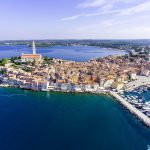ZAGREB, December 21, 2018 – Investments and personal consumption will be the main levers of GDP growth in Croatia in 2019, when economic growth is expected to slow down from the current rate of 2.8% to 2.6%, it was said at a presentation of the latest Croatian Banking Association (HUB) publication on the most important economic and financial trends and expectations for 2019.
The previously forecast increase in real GDP of 2.7% for 2018 was raised by 0.1 percentage point at the end of the year, to 2.8%. Economists evidently expect some cushioning mechanisms to become active on the domestic market, with internal growth reserves awakening, the HUB publication says.
“In 2019, we expect GDP growth in Croatia to slow down mildly, to 2.6%. The pace of investment growth will determine the growth rate,” said Zagrebačka Banka chief analyst Hrvoje Dolenec, one of the six members of the HUB Chief Economists Club, made up of the chief economists of the six biggest banks active in Croatia.
Personal consumption will continue to be the main driver of economic growth in 2019, but the economists point to investments as the most important factor. Personal consumption is expected to grow by 3.1%, and investments by 6%, with investment growth estimates ranging from 3.6% to 6.7%.
Dolenec said that the very positive expectations regarding the state budget had been slightly shaken by the prospect of enforcement of state guarantees for the Uljanik shipbuilding group. So, instead of a small surplus this year, a slight budget deficit is expected but that does not significantly change Croatia’s fiscal status, which is still good and has a positive effect on how the country is viewed internationally, he said.
Dolenec believes that Croatia is likely to return to the investment rating.
As for investments in 2019, Dolenec mentioned revived activity in the construction sector, with companies in that sector being very optimistic about 2019.
Dolenec also underlined EU funds and data from the Regional Development and EU Funds Ministry which shows that in the last two years the value of contracted projects to be implemented had increased 500%, but he warned that their fast implementation was crucial for GDP growth.
As for obstacles to growth in 2019, Dolenec underlined imbalances on the domestic labour market – a great demand for employment in some sectors on the one hand and on the other, insufficient labour supply, primarily in the tourism, IT and construction sectors, as well as in healthcare.
Analyst Velimir Šonje of Arhivanalitika said that the external risks that could slow down Croatia’s economic growth were protectionism, namely the lack of a trade agreement between the USA and China, oscillations on emerging markets, and the slowing down of China’s economic growth. Dependence on China is great around the world, and the slowdown in China can reflect on important exporters, which is why expectations in Germany, too, have been significantly revised, said Šonje.
HUB director Zdenko Adrović said that interest rates on loans had been declining for the past several years. Over the last three years, interest rates on housing loans have dropped from an average 5.7% to 3.45%, while interest rates on consumer loans have dropped from 6.5% to 5.6%. Another important group of loans, long-term corporate investment loans, have seen a drop in interest rates from 5.8% to 3.6%. “Those are favourable factors with which Croatia is entering 2019,” Adrović said.
More news on the GDP growth in Croatia can be found in our Business section.








